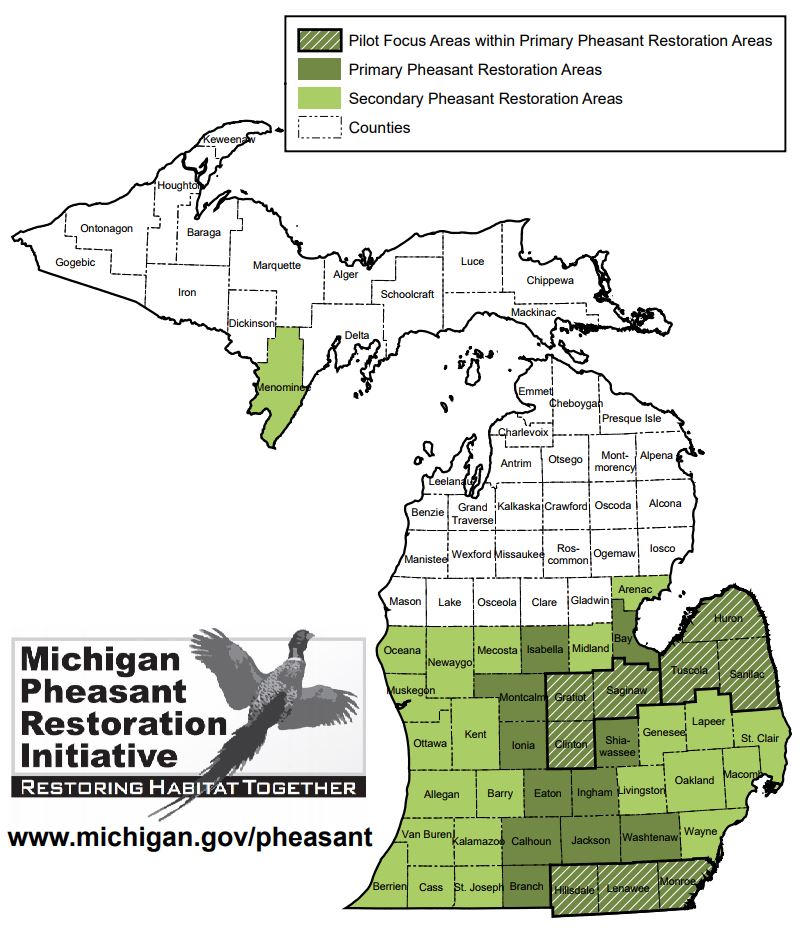Michigan Pheasant Restoration Initiative helps ringneck numbers improve. Look for a good hunting season.
By Tom Carpenter
"After reviewing survey information and reports from Pheasant Forever members and DNR field staff, I predict that pheasant hunters that hunt prime Michigan pheasant habitat will see more birds than last year,” reports Al Stewart, Upland Game Bird Specialist and Program Leader with the Michigan Department of Natural Resources.
“I'm excited about the habitat that has been created through the Michigan Pheasant Restoration Initiative, and I plan to hunt pheasants as much as I can this fall," adds Stewart. Let’s explore the background to the positive outlook in Michigan.
WEATHER
“Winter weather conditions for 2016-2017 showed similar to intermittent conditions from the previous year,” reports Stewart. “ The winter weather during 2016 was not as severe as the 2015 season. Conditions for pheasants were not considered to be harsh. Temperatures were normal for much of the winter with less deep snow than in 2014.”
“Generally, pheasant numbers in Michigan increase with mild winters (less than 19 inches snowfall) and decline with snowy winters (30+ inches snowfall),” he describes.
“Although there were heavy rainfall events in June, the remainder of the summer had warm but not hot weather with intermittent rain (there was no drought in Michigan,” says Stewart. “That was good for brood survival and for the production of insects that are important chick food.”
“Pheasant numbers increase with warm, dry springs (less than 6 inches rainfall), and decline with cold wet springs (8+ inches rainfall),” says Stewart.
SURVEYS
“Michigan’s mail-carrier brood survey was conducted in August. The preliminary survey information indicates that brood numbers are up from last year (132 in 2017 vs 86 in 2016) and pheasant chick counts are up too,” says Stewart. “Brood numbers this year are higher than recent surveys conducted in 2016, 2014, 2013, and 2011. This is good news.”
HOTSPOTS
“Some of the highest pheasant numbers are reported in the central, south-central and the ‘thumb’ regions of the state,” says Stewart.
“Michigan Hunting Access Program (
HAP) enrollment currently has 135 properties, totaling 15,710 acres,” says Stewart. “Bringing back quality pheasant hunting to Michigan is one way the DNR plans to create world-class recreational opportunities with funding from hunting and trapping license sales.”
“Areas with good pheasant habitat continue to have good bird numbers,” says Stewart. “Statewide, bird numbers are projected to be similar to last year. Based on current information, hunters should expect similar pheasant numbers as 2016 or slightly better. While pheasant numbers are far below the historical high levels of the 1950s and 1960s, pheasants still are widely distributed in southern Lower Michigan and in some areas of the Upper Peninsula.”
MICHIGAN PHEASANT RESTORATION INITIATIVE
“The Michigan Department of Natural Resources, along with many conservation partners such as Pheasants Forever, continues to expand the
Michigan Pheasant Restoration Initiative (MPRI)” says Stewart.
“Over the last five years, the activities associated with this initiative have expanded small game hunting opportunities on both public and private lands, increased wildlife populations, improved hunter satisfaction and helped Michigan's economy.” Says Stewart. “Landowners are encouraged to get involved with the MPRI. Through this initiative, property owners can get technical and financial assistance, plus help in forming local cooperatives to create and enhance pheasant habitat.
“Some of our best pheasant habitat is located on private lands and public lands within the MPRI areas,” says Stewart. Following is a map of these areas. Learn more about the MPRI
here.

MICHIGAN HUNTING NOTES
*“Hunters are most successful during the latter half of the season due to crop removal and more land open to hunting,” says Stewart. “The deer season is over and access is more readily provided after regular gun deer season is complete.”
* Pheasant season is open from October 10-31 in the Upper Peninsula; October 20-November 14 in the Lower Peninsula. The bag limit is two male pheasants per day, four in possession. The late pheasant season in part of Zone 3 (Southern Lower Peninsula) will be open from December 1-January 1 with a bag limit of two male pheasants, four in possession.
*Pheasant hunters have been harvesting nearly 22,000 wild roosters a year in Michigan, and that number should continue to rise.
GREAT OUTDOORS JAMBOREE
“Hunters and outdoor enthusiasts that wanted a total outdoor experience for the whole family can attend
The Great Outdoors Jamboree at Lake Hudson Recreation Area in Lenawee County, Michigan on September 10, 2017,” says Stewart. “This free event, provided by amazing organization partners such as Pheasants Forever, and the DNR, offers outdoor activity stations to learn the skills needed to hunt, fish and a whole lot more hands-on activities.”
LINKS
Michigan Pheasant Restoration Initiative
Michigan Hunting Access Program
Mi-HUNT Public Lands App
Tom Carpenter is Digital Content Manager for Pheasants Forever.
Lead Photo Credit: Steven Earley.